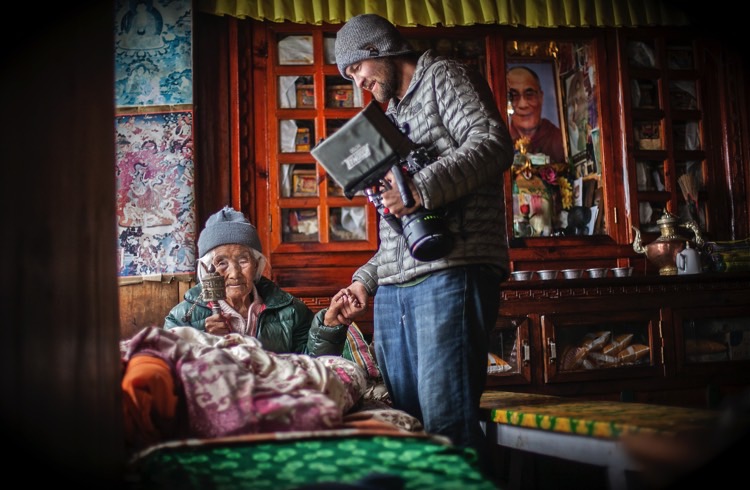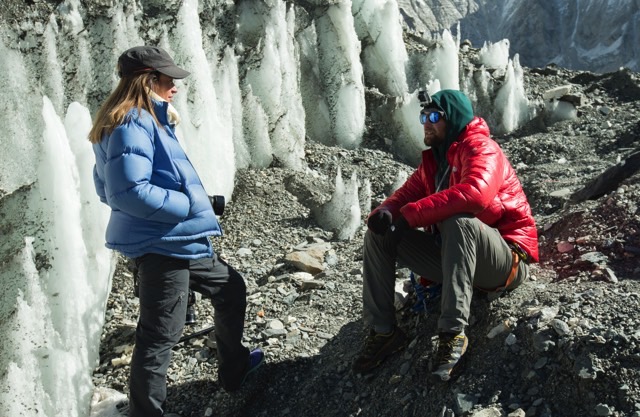The best camera work in the world will mean nothing if you don’t have a great story. Director of BAFTA-nominated film Sherpa, and our new Travel Film Scholarship judge, Jennifer Peedom explains how she lays the groundwork before shooting a film.
 Photo © Jennifer Peedom
Photo © Jennifer Peedom
I began making films back in 2000 as a participant on the Australian adventure series Race Around the World. It was the best training I could have had, because we were completely thrown in at the deep end, and had to do everything ourselves. Here, I quickly learned that the more prepared I was, the quicker I could get to the heart of the story. If you didn’t have a plan for your story, you could spend a week shooting a bunch of footage, and still not have a story – and they would put it to air anyway!
A common experience that emerging documentary filmmakers have is to think the story will reveal itself along the
- Plot Your Story
- Structure, Structure, Structure
- Drama = Conflict
- Expect the Unexpected
- Research
- Be Open to Chance
Plot your story
Before I start shooting any film, I spend a lot of time on research and planning. Whiteboards and scene cards are my friends. I always plot out what I think the three-act structure of the film might be, that is, the setup, the conflict and the resolution of the film. This can be difficult when you don’t know how the film will play out, but worth the effort, as it forces you to think about the overall themes and story structure.

Structure, structure, structure
A useful way to think about the best structure for your film is to watch and study films that have similar themes to the one you want to make. Even though I primarily make documentary films, I study the structure of drama films as well as documentaries. As you watch the characters in these other films, you can think about your own characters: what they want, what challenges lie ahead for them, and what they might need to learn in order to achieve their goals or achieve their ‘want’.
Drama = conflict
All stories need conflict of some kind, as there is no drama without conflict, and yes, this goes for
Expect the unexpected
The great thing about all this planning is that when things don’t go to plan in the field, (expect the unexpected), then you’ve still got this basic story structure to come back to.
When I shot Sherpa on Mount Everest, our plan was to follow an Everest expedition from the Sherpa POV, focusing on
Think of it like this: if the film is the journey, the story structure is the roadmap. Having a roadmap that year on Everest, really helped me pivot when the crisis happened, and still come home with a story.

Research
How much research to do before you go depends on many things, like how well you already know the subject matter, what kind of story you are telling, and who the audience is. As a rule, you can never be too prepared. I had already worked on three Himalayan expeditions with the same team of Sherpas, so I had a good idea of how some of the conflicts might play out on the mountain. The more you know, the more credibility you’ll have when dealing with subjects.
Be open to chance
The more prepared you are, and the more you understand the themes of your film, the more likely you’ll be able to have your eyes open to characters that you hadn’t considered in the original plan.
A good example of this in Sherpa was the Sherpa women, as they helped tell the bigger story of the Sherpas on Everest. You wouldn’t expect the wives and mothers staying at home to be important characters in a film about an Everest expedition, but in the end, they were probably the most important characters, as they provided the most powerful conflict. We had expected most of the conflict to happen between the Sherpas and the foreign clients, and while this also happened, the more subtle conflict, between Phurba Tashi and his own family, helped highlight the most important themes of the film, family, spirituality
Be prepared. Expect the unexpected and remember that all the best camera work in the world will mean nothing if you don’t have a great story.
Related articles
Simple and flexible travel insurance
You can buy at home or while traveling, and claim online from anywhere in the world. With 150+ adventure activities covered and 24/7 emergency assistance.
Get a quote

2 Comments
This was actually beautifully helpful! Thank you so much for sharing!
This is all so helpful and I am reading your articles voraciously! Really good information.
Do you think there will be a Travel Film/Filmmaking Scholarship in 2019?
If so, I am very interested in learning more!
v/r
Lara